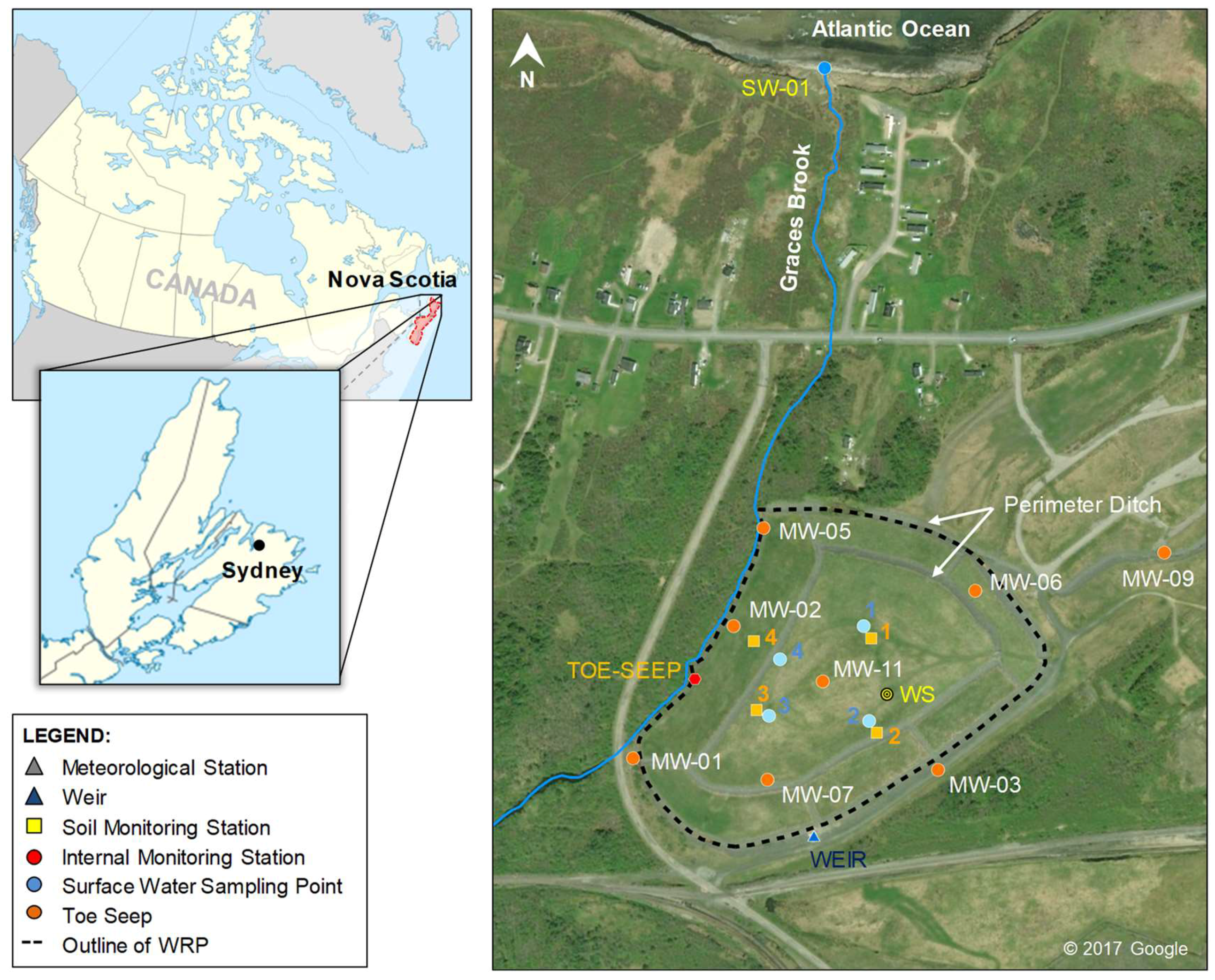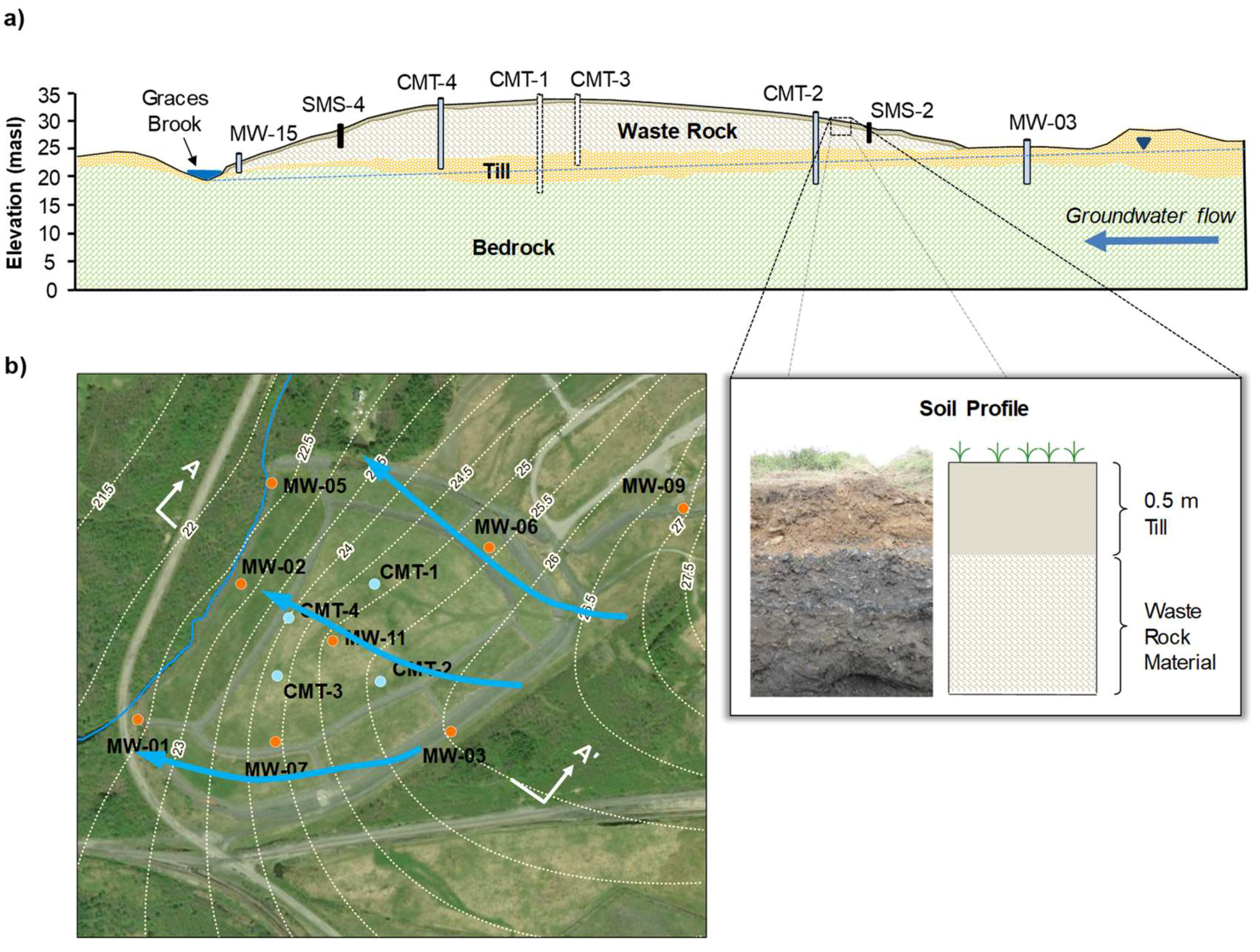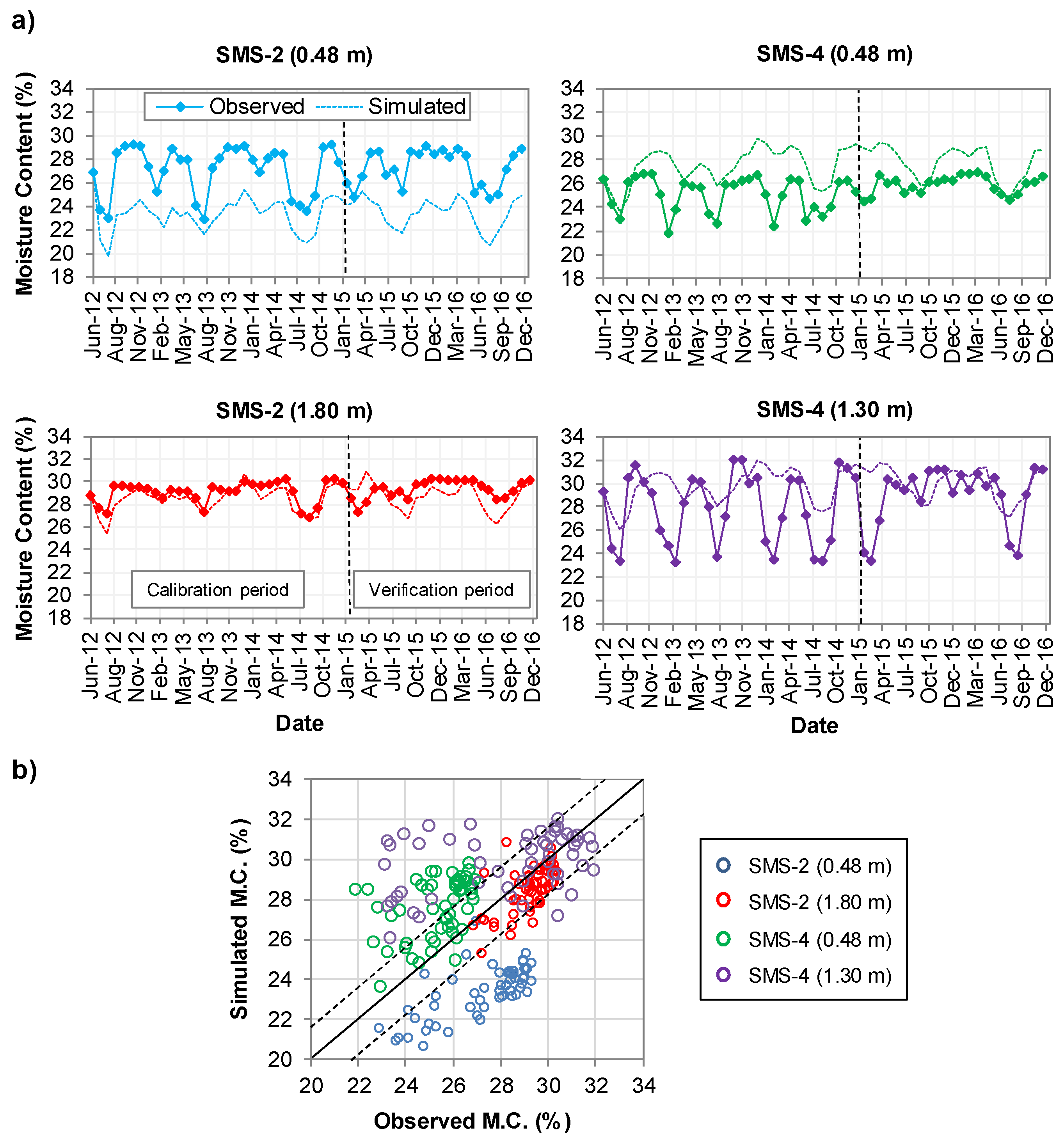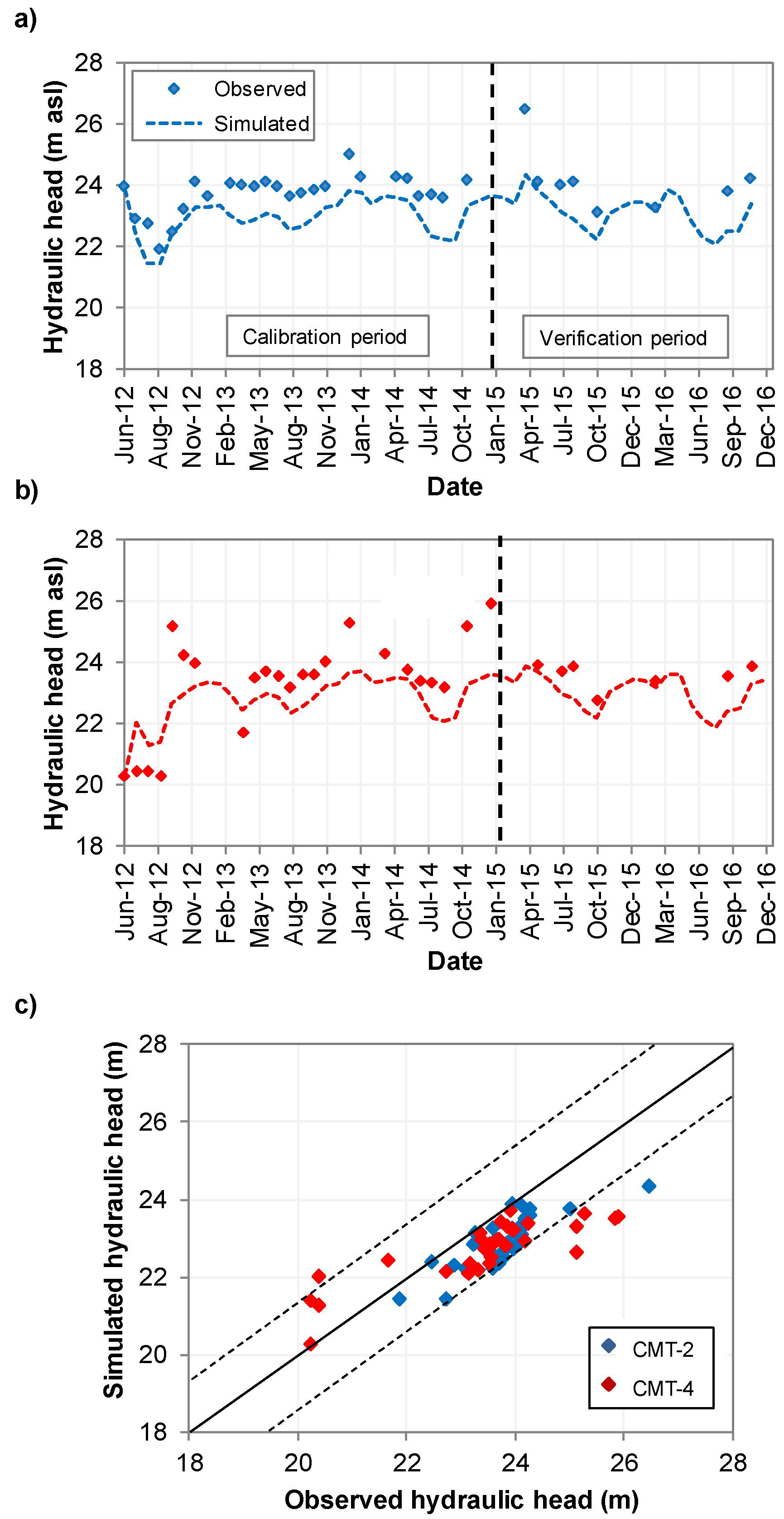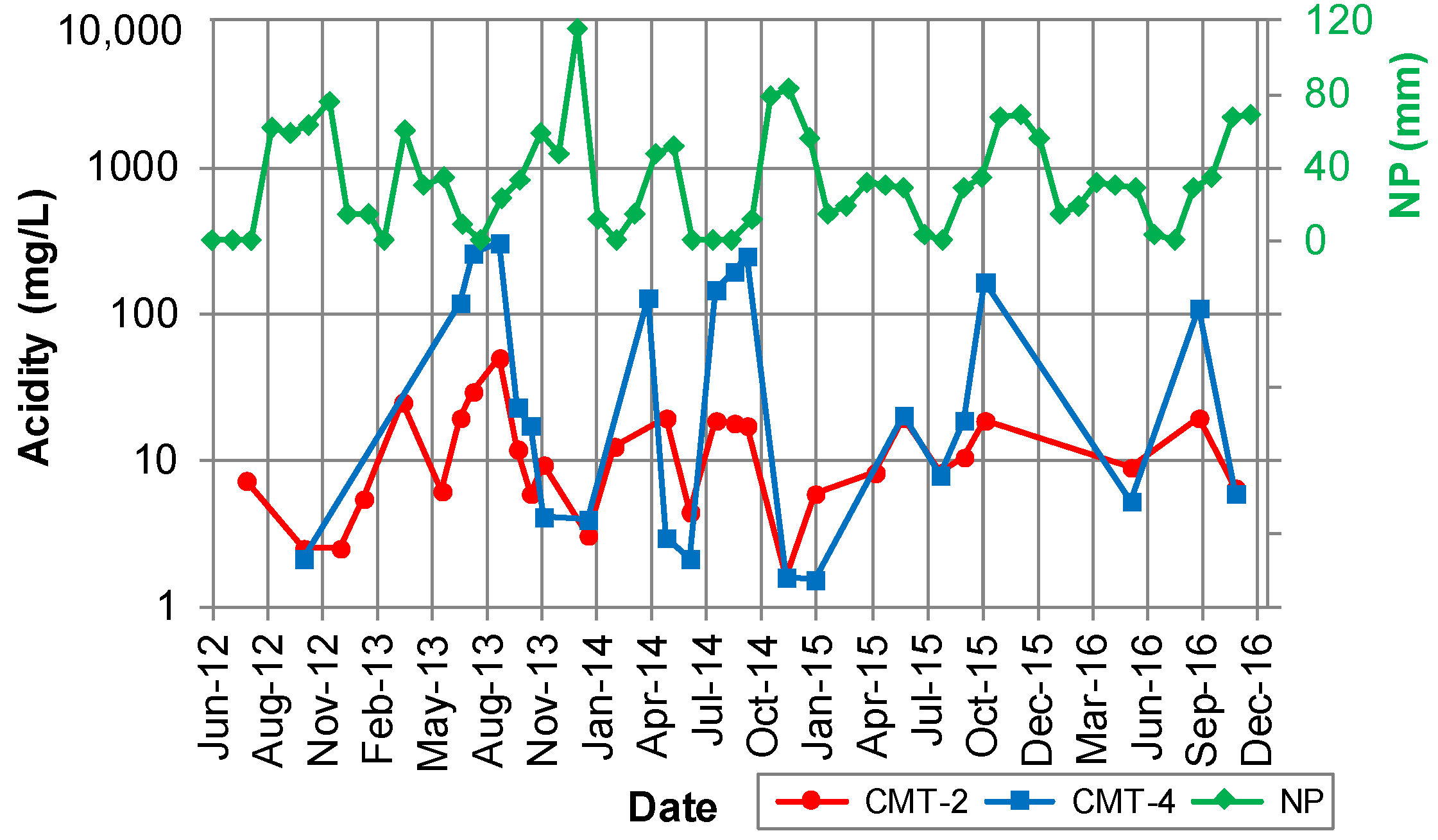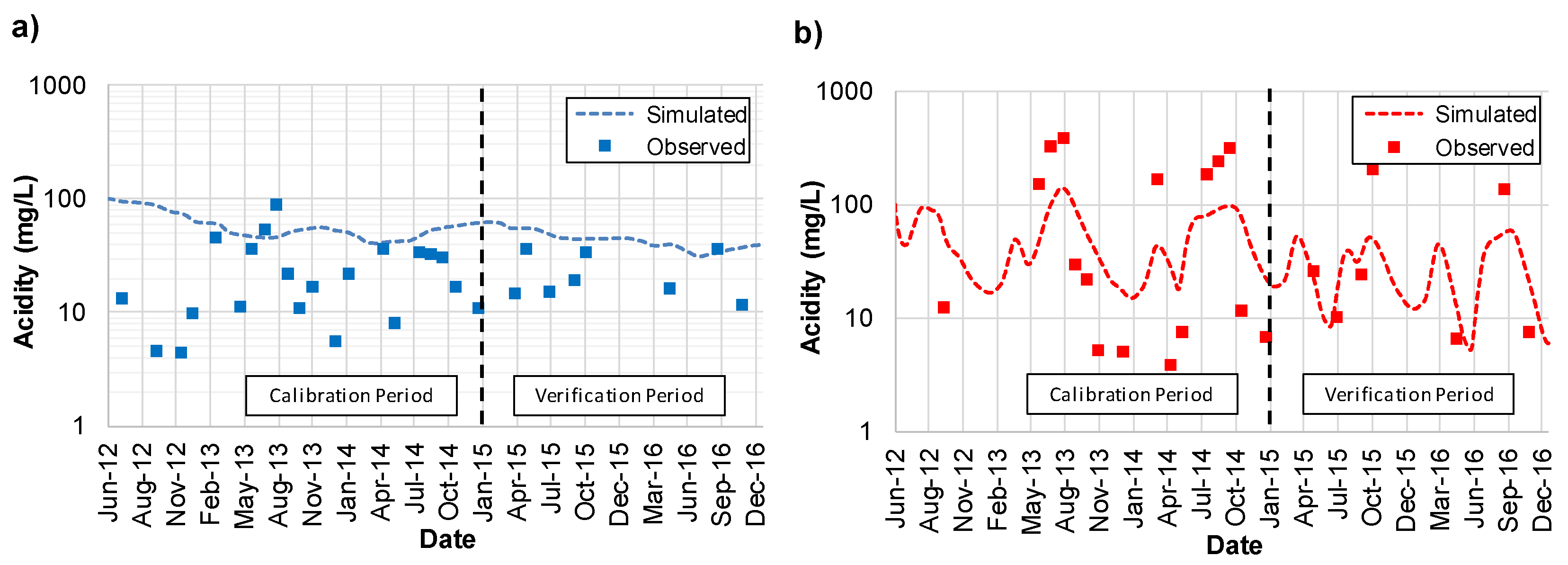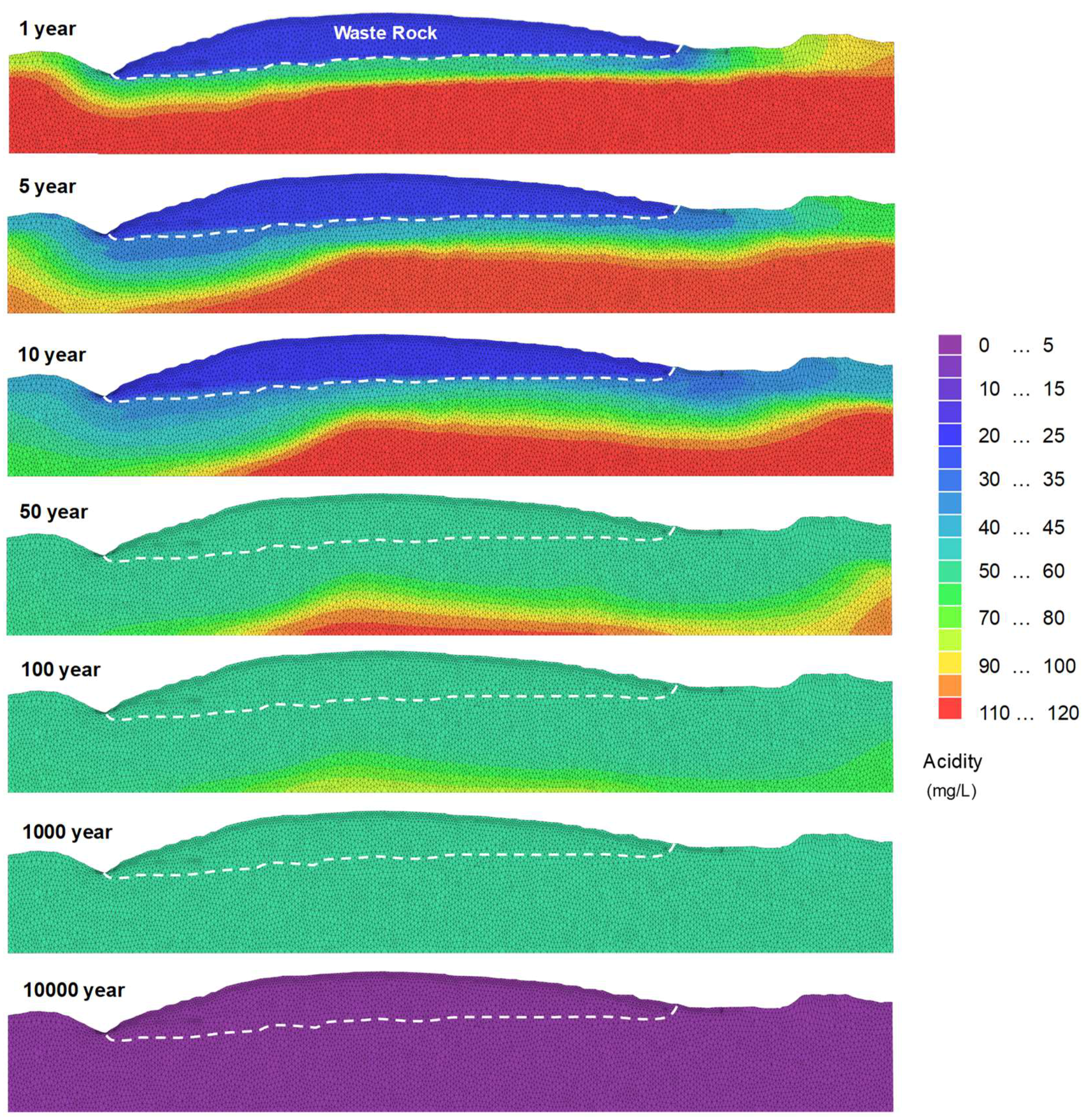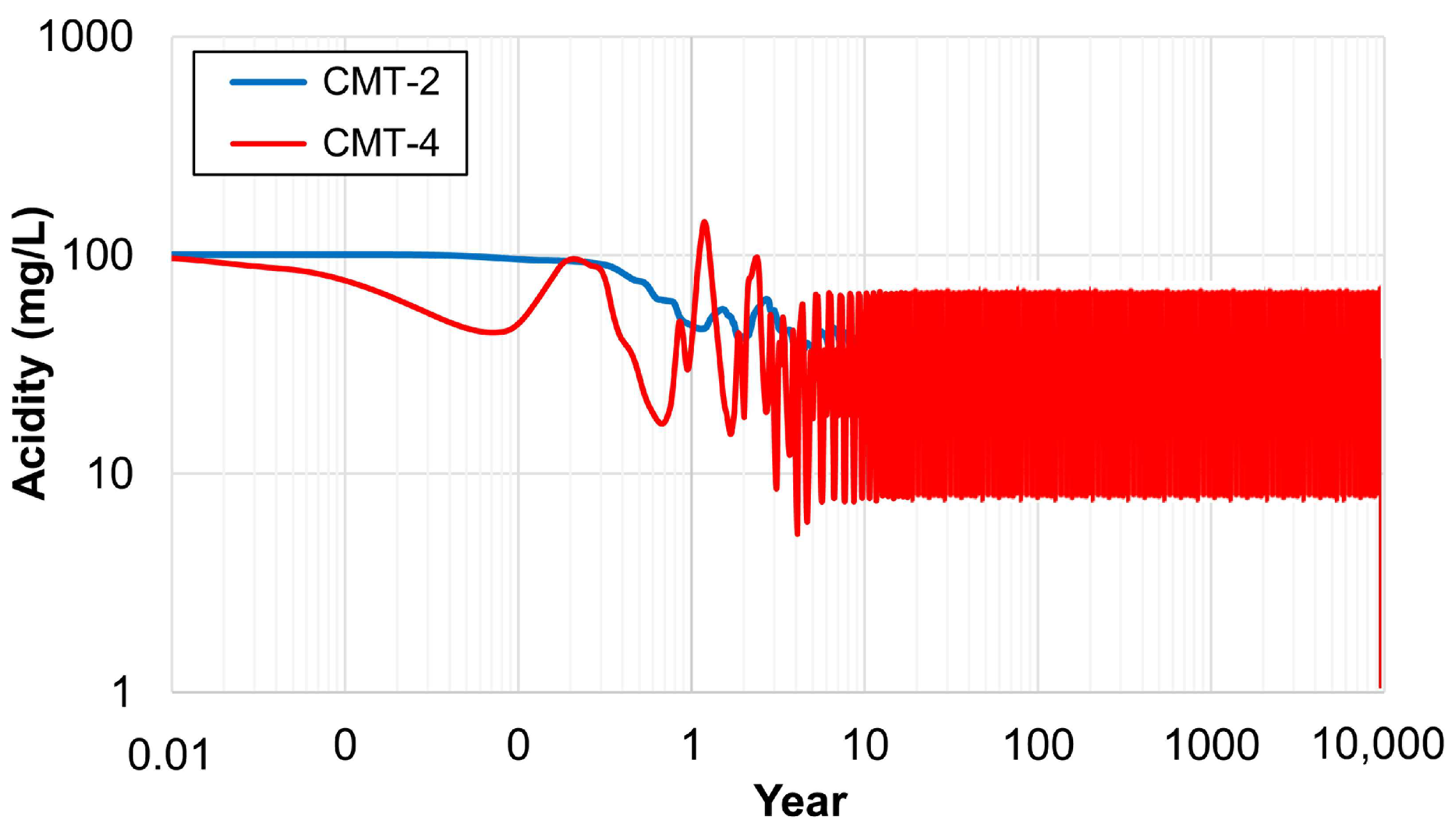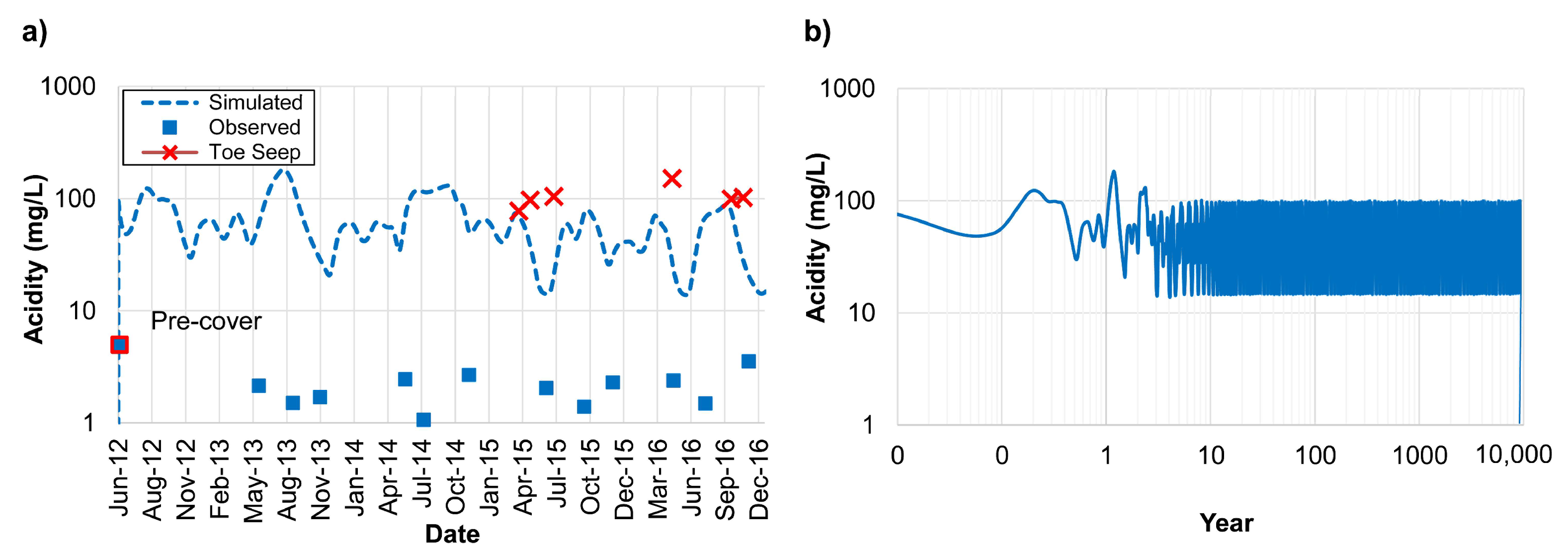1. Introduction
Mine waste rock piles (WRPs) are large accumulations of waste rock, fine coal, tailings and other mining and processing wastes. WRPs can contain significant amounts of reactive sulphide minerals, including pyrite and pyrrhotite, which when exposed to oxygen and water, can generate acid mine drainage (AMD). This AMD is generally characterized by low pH and high concentrations of sulphate, heavy metals and other toxic elements [
1,
2,
3]. As a result, WRPs have the capacity to cause severe environmental impacts, particularly on soil, water resources and aquatic communities [
4,
5]. Numerous studies provide detailed reviews of AMD components, including geochemistry [
6], impacts [
7] and remediation options [
8].
To prevent and/or control the generation of AMD, cover systems are installed over the WRP to isolate the reactive waste from the atmosphere and thereby limit the influx of meteoric water and atmospheric oxygen to the waste rock [
9,
10]. The design of a cover system is site-specific and dependent on several factors, including site conditions (i.e., climate, hydrogeology, waste rock geochemistry), installation complexity and cost, material availability and site closure objectives [
11,
12]. As a result, numerous covers exist, ranging from a single-layer of earthen material to multiple layers of different materials such as native soils, organic materials and geosynthetics [
12,
13,
14,
15,
16].
Single-layer cover systems are the most straightforward option to implement and maintain at WRPs. A single layer of earthen material uses the moisture ‘store-and-release’ concept to limit water influx by storing infiltrating water within the material and subsequently releasing it back to the atmosphere via evapotranspiration. The earthen material also provides a medium for the establishment of a vegetative canopy. This cover type is most commonly used in semi-arid and arid climates, where potential evaporation exceeds precipitation [
17,
18].
In humid regions, water storage can be overwhelmed in the earthen material layer. Monolayer covers with elevated water table have been effective in humid climates to act as a barrier to oxygen influx and prevent new AMD generation [
19]. Multi-layer systems have also been applied, which include layered covers with capillary barrier effects (CCBE) [
20], geosynthetic clay liner (GCL) [
21] or geomembrane liner [
12]. However, these more complex and expensive systems can also suffer in humid climates. For example, it can be challenging for CCBE covers to maintain a high degree of saturation all year (i.e., high evaporation during summer months; freeze and thaw effects) [
22], while GCLs can be significantly affected by desiccation and freeze-thaw cycling [
23]. As a result, single-layer covers can still be an attractive closure option at WRP sites: They are the least complex and most inexpensive system to both install and maintain and can meet other key performance criteria at WRPs, such as landform stability, sustainable vegetation canopy and removal of contaminated surface water runoff [
15].
Historically, cover performance has been evaluated by monitoring various parameters within the WRP, such as site-specific climate, pore-gas concentrations, moisture content, net percolation and seepage water quality [
24,
25]. Power et al. [
15] demonstrated the application of a single-layer cover to (i) eliminate contaminated surface water runoff, (ii) minimize AMD impacts to surface water receptors, (iii) maintain a stable landform and (iv) provide a sustainable vegetative canopy. While these field studies have been able to directly assess single-layer cover performance, they are limited to the short-term immediately following installation (≤5 years). No information is available on long-term cover performance and associated AMD evolution.
Numerical modeling is necessary to predict the long-term evolution of groundwater contaminants during and/or following remediation, including chlorinated solvents [
26], acid mine drainage [
27] and landfill leachate [
28]. In WRP studies, numerical models have been used to examine various processes occurring within the waste rock, ranging from unsaturated water flow in hypothetical WRPs [
29] to complete representations of sulphide oxidation (including heat transport, diffusive and convective air transport, spatially and temporally dependent pyrite oxidation rates) at full-scale WRPs [
30,
31,
32]. A comprehensive review of WRP numerical modeling studies is provided by Amos et al. [
1].
While complex hydrological and geochemical processes within WRPs have been studied, a very limited number of studies have simulated the spatial and temporal evolution of AMD emanating from WRPs. The evolution of AMD impacts on groundwater quality at a WRP site remediated with a geomembrane-lined cover has been simulated [
27]; however, no study has incorporated the unsaturated flow through the WRP following remediation, which is still significant when a single-layer soil cover is installed. In addition to AMD, analogous studies have simulated the migration of groundwater plumes containing RDX and nitrate [
33] and acrylonitrile [
34].
In this study, a numerical investigation is presented of a remediated mining site that includes a WRP overlain with a single-layer moisture ‘store-and-release’ cover system. A two-dimensional (2D) variably saturated water flow and contaminant transport model of the study site was developed in FEFLOW and then calibrated and verified with key parameters collected during post-remediation field monitoring. The model was then simulated for 10,000 years to predict the spatial and temporal evolution of AMD and assess the long-term effectiveness of remediation.
4. Results and Discussion
4.1. AMD in Groundwater
Figure 9 presents the predicted spatial and temporal distribution of the acidity contaminant plume over the 10,000-year simulation period. After 1 year, the WRP source concentrations had begun to seep into and dilute the underlying groundwater. While the general groundwater flow was from west-to-east, mounding of the water table within the center of the pile generates local gradients to both the west and east directions. Within 100 years, the pre-cover groundwater acidity of 115.55 mg/L had almost all continually improved to the post-cover pile acidity (mean = 50.72 mg/L). At 10,000 years, the pile source acidity was depleted and groundwater concentrations had decreased to the target concentration of 1.75 mg/L.
To better analyze the evolution of the AMD plume,
Figure 10 presents the acidity concentrations in groundwater at CMT-2 and CMT-4. Acidity concentrations at both wells improve from their initial pre-cover concentrations to the post-cover seepage concentrations. At 9229 years, the acidity at CMT-2 and CMT-4 decreases to the target concentration of 1.75 mg/L.
4.2. AMD in Surface Water
As shown in
Figure 9, the groundwater plume migrates to the left-hand side of the model domain towards the key environmental receptor Graces Brook, which flows adjacent to the WRP (see
Figure 1). As part of the field monitoring program, acidity concentrations were monitored at a location in Graces Brook downstream of the WRP.
Figure 11a presents the acidity concentrations observed at Graces Brook (blue squares) between 2012 and 2016, with the mean pre-cover acidity concentration indicated by the large red-outlined square. This field observed data indicates that water quality in Graces Brook is gradually improving over time. Acidity concentrations measured at the toe seep are indicated by red x’s.
While modeling Graces Brook was beyond the scope of this work, the flow model was used to indirectly assess long-term AMD impacts to Graces Brook. An observation point in the model domain directly below Graces Brook was used to monitor acidity concentrations over time. These simulated concentrations in groundwater at Graces Brook were also plotted in
Figure 11a (blue line). It is evident that the simulated acidity concentrations closely followed the same trend as observed acidity concentrations.
While trends were similar, there was a large discrepancy in concentration magnitude, with observed concentrations much lower than simulated concentrations. The observed concentrations were based on water samples collected from Graces Brook, with concentrations impacted by dilution from high water velocity, rainfall and/or surface water runoff. It also indicates that groundwater was not easily discharging into Graces Brook.
In contrast, the observed toe seep concentrations were based on water samples taken directly from ‘daylighting’ groundwater, which then overflowed on the surface directly into Graces Brook. As shown in
Figure 11a, the toe seep concentrations were very similar to the simulated concentrations, which was expected as the toe seep water was coming from groundwater at that location.
Figure 11b presents the predicted acidity concentrations over the long-term in groundwater directly below Graces Brook. It is evident that groundwater (and surface water) quality would continue to improve over time until WRP acidity is depleted at 9229 years. Therefore, the remedial performance objectives, which were already being met during the field monitoring program [
15], will continue to be achieved over the long-term.
4.3. Model Limitations
It is acknowledged that a number of simplifying assumptions were used in this study. The model layers were assumed to be homogeneous and isotropic, which might be overly simplistic as WRP and geologic units are typically heterogeneous and complex. Therefore, it is acknowledged that this assumption simplifies water flow and contaminant distribution in the model simulation. Mean values used for hydrogeological parameters, such as hydraulic conductivity and porosity, might have led to underestimation, or overestimation, of simulated data (e.g., moisture contents and hydraulic heads) and increased discrepancies with observed data, as evident during model calibration. These discrepancies could then lead to inaccuracies in flow velocities and contaminant concentrations. Nevertheless, it is common in large and complex study areas to assume representative mean values. The mean values used were carefully selected and then subsequently adjusted to obtain the well-calibrated and verified flow and contaminant transport model.
Using the field monitoring data and water balance method, a relationship was developed between NP and precipitation. This monthly NP as a percentage of precipitation was then applied to long-term climatic variations to generate long-term NP rates for the predictive models. simulation. It is acknowledged that a fully calibrated soil-atmosphere model such as VADOSE/W [
49] could be used to incorporate climate variability and predict long-term NP through the cover system [
14].
It was not possible to obtain pore-water samples directly from the waste rock, as the CMT wells were screened below the waste rock into the shallow bedrock; therefore, groundwater samples from the underlying bedrock were used to represent water quality seeping from the WRP. As a result, acidity generation and loading is likely underestimated as it based on groundwater concentrations that may have already diminished due to dilution with upgradient groundwater. The assumption of homogeneity was also applied to the WRP source concentration, which was taken as the mean acidity concentration from two sampling points (i.e., CMT-2 and CMT-4). Furthermore, the calculated acidity values used in this study assumed there was no buffering within the pile, thereby providing a conservative estimate of acidity seeping from the WRP.
Due to the limited information available and low sampling density at the study site, the modeling was performed in 2D along a representative cross-section through the WRP. It is acknowledged that the 2D model results might be limited the variably saturated flow regime and the AMD contaminant plume transport at the site is 3D in nature.
It is acknowledged that kinetic aspects would need to be incorporated to more accurately access the annual generation and release of AMD to groundwater. Current work involves laboratory tests with humidity cells and leaching columns on waste rock samples to assess various kinetic aspects such as the velocity of sulphide oxidation and metal leaching rates. Future work will incorporate the PHREEQC geochemical reaction model [
50] into the FEFLOW model to include kinetic and multiphase transfer processes for improved long-term AMD predictions.
5. Conclusions
A numerical investigation was conducted to predict the long-term performance of a single-layer cover system installed over an acid-generating WRP. In 2011, the Lingan WRP in Nova Scotia, Canada was remediated with a single-layer moisture ‘store-and-release’ cover system. The field monitoring program demonstrated that the cover system generated a small reduction in water infiltration into the WRP, decreasing from 34% to 28% of precipitation. Furthermore, the placement of the cover over the previously exposed waste rock ensured only clean surface water runoff to the adjacent surface water receptor (Graces Brook), with groundwater discharge now the primary source of AMD contamination.
A 2D variably saturated flow and contaminant transport model of the site (WRP and receiving environment), was developed in FEFLOW. Key field parameters observed during post-remediation field monitoring, including moisture content and hydraulic head, were used to effectively calibrate and verify the model.
The model was used to simulate the long-term spatial and temporal distribution of AMD over a 10,000-year period, which was based on the estimated time to acidity depletion in the WRP. Groundwater quality was predicted to improve from initial pre-cover acidity to post-cover pile seepage acidity within 100 years, before eventually reaching background water quality following source depletion at 9229 years. A key site remedial objective was related to water quality improvement in Graces Brook, whose long-term source of AMD contamination was from groundwater discharge. The model was used to confirm that groundwater quality adjacent to Graces Brook (i.e., point of discharge) continually improved over the long-term, thereby indirectly predicting the long-term improvement of Graces Brook.
This study demonstrated the effective long-term performance of a single-layer cover system to reduce the impacts of AMD on the WRP receiving environment. While the findings were from a single field site, they are applicable to other WRP sites reclaimed with a single-layer cover system. Nevertheless, it should be noted that cover performance evolves over time in response to climatic conditions and site-specific physical, chemical and biological processes that are extremely difficult to incorporate in predictive models. If possible, periodic monitoring and physical studies of in situ processes such as freeze-thaw, vegetation and erosion cycles should be conducted to maintain a rigorous evaluation of long-term cover performance.
